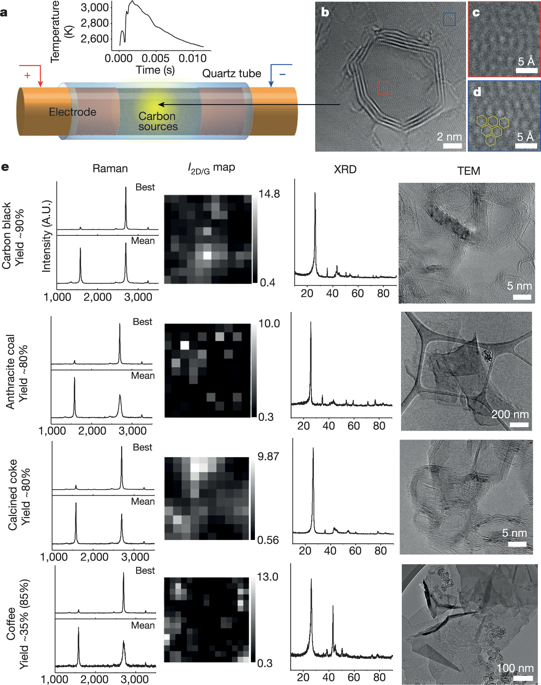Nature ( IF 50.5 ) Pub Date : 2020-01-27 , DOI: 10.1038/s41586-020-1938-0 Duy X Luong 1, 2 , Ksenia V Bets 3 , Wala Ali Algozeeb 2 , Michael G Stanford 2 , Carter Kittrell 2 , Weiyin Chen 2 , Rodrigo V Salvatierra 2 , Muqing Ren 2 , Emily A McHugh 2 , Paul A Advincula 2 , Zhe Wang 2 , Mahesh Bhatt 4 , Hua Guo 3 , Vladimir Mancevski 2 , Rouzbeh Shahsavari 4, 5 , Boris I Yakobson 2, 3, 6 , James M Tour 2, 3, 6

|
Most bulk-scale graphene is produced by a top-down approach, exfoliating graphite, which often requires large amounts of solvent with high-energy mixing, shearing, sonication or electrochemical treatment1,2,3. Although chemical oxidation of graphite to graphene oxide promotes exfoliation, it requires harsh oxidants and leaves the graphene with a defective perforated structure after the subsequent reduction step3,4. Bottom-up synthesis of high-quality graphene is often restricted to ultrasmall amounts if performed by chemical vapour deposition or advanced synthetic organic methods, or it provides a defect-ridden structure if carried out in bulk solution4,5,6. Here we show that flash Joule heating of inexpensive carbon sources—such as coal, petroleum coke, biochar, carbon black, discarded food, rubber tyres and mixed plastic waste—can afford gram-scale quantities of graphene in less than one second. The product, named flash graphene (FG) after the process used to produce it, shows turbostratic arrangement (that is, little order) between the stacked graphene layers. FG synthesis uses no furnace and no solvents or reactive gases. Yields depend on the carbon content of the source; when using a high-carbon source, such as carbon black, anthracitic coal or calcined coke, yields can range from 80 to 90 per cent with carbon purity greater than 99 per cent. No purification steps are necessary. Raman spectroscopy analysis shows a low-intensity or absent D band for FG, indicating that FG has among the lowest defect concentrations reported so far for graphene, and confirms the turbostratic stacking of FG, which is clearly distinguished from turbostratic graphite. The disordered orientation of FG layers facilitates its rapid exfoliation upon mixing during composite formation. The electric energy cost for FG synthesis is only about 7.2 kilojoules per gram, which could render FG suitable for use in bulk composites of plastic, metals, plywood, concrete and other building materials.
中文翻译:

克级自下而上闪光石墨烯合成
大多数大块石墨烯是通过自上而下的方法生产的,即剥离石墨,这通常需要大量溶剂进行高能混合、剪切、超声或电化学处理1,2,3。虽然石墨化学氧化为氧化石墨烯会促进剥离,但它需要苛刻的氧化剂,并在随后的还原步骤3,4后留下有缺陷的穿孔结构的石墨烯。如果通过化学气相沉积或先进的有机合成方法进行高质量石墨烯的自下而上合成,通常仅限于超少量,或者如果在本体溶液中进行,它会提供缺陷较多的结构4,5,6. 在这里,我们展示了廉价碳源(如煤、石油焦、生物炭、炭黑、废弃食品、橡胶轮胎和混合塑料废物)的闪焦焦耳加热可以在不到一秒的时间内提供克级数量的石墨烯。该产品在用于生产它的工艺之后被命名为闪光石墨烯 (FG),它显示了堆叠的石墨烯层之间的湍流排列(即小顺序)。FG 合成不使用熔炉,不使用溶剂或反应性气体。产量取决于来源的碳含量;当使用碳黑、无烟煤或煅烧焦炭等高碳源时,产率可以在 80% 到 90% 之间,碳纯度大于 99%。无需纯化步骤。拉曼光谱分析显示 FG 的 D 带强度低或缺失,表明 FG 具有迄今为止报道的石墨烯中最低的缺陷浓度,并证实了 FG 的乱层堆叠,这与乱层石墨明显不同。FG 层的无序取向有利于其在复合材料形成过程中混合时的快速剥离。FG合成的电能成本仅为每克约7.2千焦耳,这可以使FG适用于塑料、金属、胶合板、混凝土和其他建筑材料的散装复合材料。











































 京公网安备 11010802027423号
京公网安备 11010802027423号